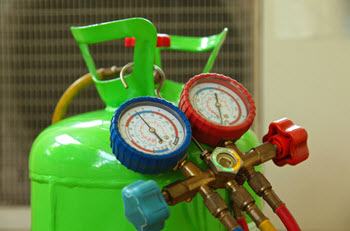Does Your AC Use R-22? Here’s What You Should Consider

Central air conditioning systems are typically unsung heroes in keeping your home cool during blistering hot & humid summer days. However, if your HVAC system breaks down this summer and your system is older than 15 years, you have a huge decision to make – repair vs replace! This is due to the US Government’s mandatory R-22 refrigerant phase-out that was finalized on January 1, 2020. Owners of old home R-22 air conditioning units will have to either give way to newer models or have a hefty repair bill on their hands because of the following reasons:
What Year Was R-22 Totally Banned In The US?
Contents
- 1 What Year Was R-22 Totally Banned In The US?
- 2 Is R22 Refrigerant Still Available In Massachusetts?
- 3 Why Was R22 Banned? Environmental Damage By Continued Use Of R-22
- 4 Energy Efficiency And Refrigerant Comparison: R-22 Vs R410a. Which Is Better?
- 5 How Much Is R-22 Refrigerant Per Pound in 2021 – Why Is Refrigerant So Expensive?
- 6 Central Air Conditioning Prices: HVAC Tax Credit 2021 & AC Savings
- 7 Conclusion
The substance called R-22, your cooling system’s refrigerant, used to be the standard. It enjoyed widespread adoption thanks to its ability to help HVAC systems extract heat indoors and pump it outdoors. However, it has since fallen out of favor because of issues regarding its impact on the environment. Due to government regulations, the HVAC industry has poured resources into developing better alternatives and the US government has severely regulated its use. As of January 1, 2020, it was illegal to make or import R-22 into the US.
Is R22 Refrigerant Still Available In Massachusetts?
Yes, it is available, however, it has become extremely expensive since the production is illegal and the demand is large. In some cases, it may cost as much as $2,000 to recharge your home central air-conditioning system. The larger the AC system, the more expensive your refrigerant charge will be. Savvy homeowners will start to compare the cost of recharging older central AC units that are declining in energy efficiency versus upgrading their central cooling systems.
Contact us today for a free assessment and cost analysis for your home cooling systems.
As of January 2020, R-22 refrigerant was no longer being produced or imported into the United States. Consequently, if your home’s cooling system needs a recharge this year or after, you will have no choice but to pay astronomical costs for an R22 refill or replace your HVAC equipment. Take advantage of lower prices this year if your home AC system is older than 15 years.
Why Was R22 Banned? Environmental Damage By Continued Use Of R-22
 The main driving force behind the fall of R-22 is the discovery of its harmful effects on the environment. It contains hydrochlorofluorocarbons or HCFCs[1] that destroy the ozone layer. Without this protective shield, we become more vulnerable to ultraviolet radiation. The good news is that the large hole that was found on the ozone layer has shrunk in size years after HCFCs and other ozone-depleting substances were banned in many countries.[2] If your home’s central air conditioning equipment still uses R22 refrigerant, then you can do your part by shifting to a newer and safer system that utilizes the replacement refrigerant for R22, Puron (R-410a).
The main driving force behind the fall of R-22 is the discovery of its harmful effects on the environment. It contains hydrochlorofluorocarbons or HCFCs[1] that destroy the ozone layer. Without this protective shield, we become more vulnerable to ultraviolet radiation. The good news is that the large hole that was found on the ozone layer has shrunk in size years after HCFCs and other ozone-depleting substances were banned in many countries.[2] If your home’s central air conditioning equipment still uses R22 refrigerant, then you can do your part by shifting to a newer and safer system that utilizes the replacement refrigerant for R22, Puron (R-410a).
Energy Efficiency And Refrigerant Comparison: R-22 Vs R410a. Which Is Better?
What Are The Differences Between R-22 & R-410a?
Additionally, all HVAC systems suffer from a deterioration in efficiency as they age. Dirt and dust accumulate on the surfaces. Friction results in wear and tear. Pressure builds up until cracks and leaks develop. Although old air conditioners can still keep homes cool, they will require much more power to do so compared to when they were new. The increased consumption also increases the monthly expenses. It may become financially sensible to buy a high-efficiency system and enjoy lower bills.
Furthermore, advancements in heating and cooling technology continue to improve the energy efficiency of our HVAC systems. With all things being held equal, if you compared an air-conditioning system from 2005 versus a modern air conditioning system, the energy efficiency of the newer unit is far superior! When compounded with normal wear and tear and degradation of efficiency due to age, a modern system makes economic sense as an alternative to your old home air conditioning unit.
How Much Is R-22 Refrigerant Per Pound in 2021 – Why Is Refrigerant So Expensive?
 R-22 is still available this year but the cost is already sky-high. The R-22 phase-out discouraged manufacturers from making more of the substance even before the 2020 cut-off date. Currently, the low supply and high demand are continually pushing the price up.
R-22 is still available this year but the cost is already sky-high. The R-22 phase-out discouraged manufacturers from making more of the substance even before the 2020 cut-off date. Currently, the low supply and high demand are continually pushing the price up.
If your home’s air conditioning system has a leak or your refrigerant falls below critical levels, you will be faced with an exorbitantly large air conditioning repair bill this summer. If your air conditioning repair needs to be done later in the season, chances are the expense of R-22 refrigerant will be much higher than it is today. Essentially, we anticipate the pricing of R-22 to steadily increase as the season progresses and the supply of this coolant dwindles.
Central Air Conditioning Prices: HVAC Tax Credit 2021 & AC Savings
The government has sought to encourage people to upgrade their older cooling systems by offering perks to buyers of new HVAC units. Consumers can enjoy tax breaks to help offset the cost of a new AC system. Learn more about the computations from the ACCA or Air Conditioning Contractors of America.
Typically, your savings on an upgrade of an air conditioning system is tied to the Seasonal Energy Efficiency Ratio otherwise known as SEER. The higher the rating, the more savings you can expect to receive in the form of rebates, tax credits, and incentives. In addition to the price breaks on upgrading your central AC system, higher SEER ratings equate to better efficiency and less operational costs for your home’s cooling equipment.
Like miles per gallon in the car, the higher the system seer rating, the more comfort you will get from each energy dollar. Today’s best air conditioners use 30% to 50% less energy to produce the same amount of cooling as air conditioners made in the mid-1970s. Even if your air conditioner is only 10 years old, you may save 20% to 40% of your cooling energy costs by replacing it with a newer, more efficient model.[3]
Contact us to get specifics on the available tax breaks in your area and to learn about all of our other money-saving offers with regards to HVAC upgrades in Massachusetts. Call (800) 888-2888 today to schedule your free, in-home HVAC assessment.
Conclusion
Townsend Energy is a trusted HVAC service provider that offers affordable HVAC services for residential and commercial properties. We are proud to provide exceptional services for your heating and cooling requirements such as repairs, installation, and tune-ups as well as maintenance tasks.
We outshine the competition in every area with friendly service, efficient installation, and affordable prices.
To learn more about the services and systems we offer, contact Townsend Energy today. We will schedule an appointment so that you can meet with one of our professionals for a free consultation. We will be happy to discuss your concerns and find the best available cooling solutions. We’ll answer all your questions thoroughly. Call now!
Click here to contact us now or you can call us at (800) 888-2888 to find out more!
[1] Phaseout of Ozone-Depleting Substances (ODS) (https://www.epa.gov/ods-phaseout)
[2] Ozone depletion, explained (https://www.nationalgeographic.com/environment/global-warming/ozone-depletion/)
[3] US Department of Energy (https://www.energy.gov/energysaver/central-air-conditioning)
